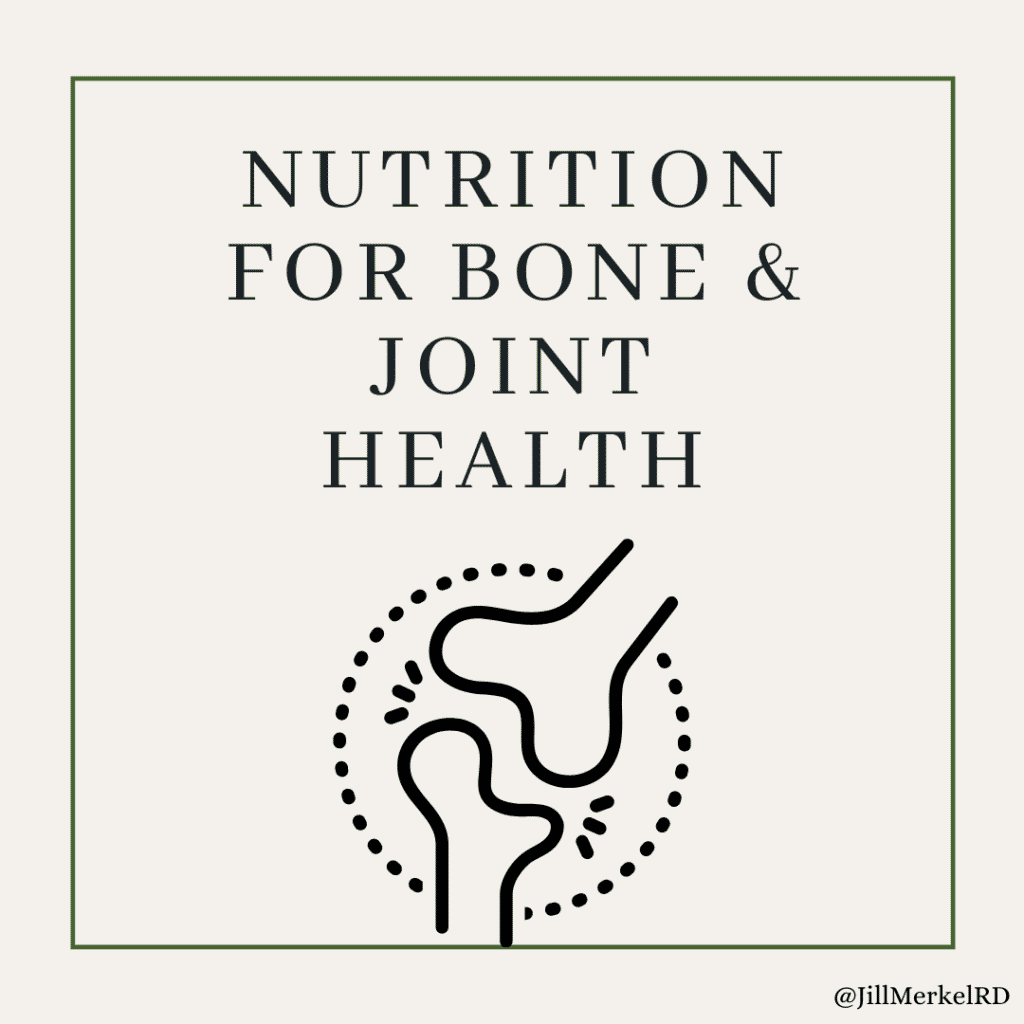Why should you care about nutrition for bone & joint health as an athlete or a recreational exerciser? Let’s take a closer look!

Nutrition for Bone & Joint Health
Your bones contain various minerals and protein complexes. Therefore, they are a mineral pool in which the body can take minerals and supply them to other parts of the body, like the bloodstream, in times when those areas are depleted. This means that bones are constantly being restructured and altered depending on what the body needs. Around 20 years old, your bones reach a point where they achieve 90% of peak bone mass. Prior to that, bones are growing in size and shape and are highly manipulatable to nutrition and weight-bearing exercise. After 30, bone mass gradually declines, and nutrition and weight-bearing exercise become essential to slowing that decline.
By not optimizing your nutrition for bone health, you can be lowering that peak bone mass to less than what it could be. As a result, osteopenia can come sooner rather than later.
Knowing our current bone status is not readily at our disposal. However, two common signs that signal poor bone health are stress fractures and irregular menstrual cycles or loss of menstrual cycles for women. Stress fractures are caused by rhythmic and repeated application of mechanical loading, which is why they are common in track and field and aerobic sports. Having one or multiple stress fractures is a sign that your bones are sub-optimally nourished. Loss of menstrual cycles or irregular menstrual cycles are also a sign of under-feeding and poor bone health.
Reproductive organs and bone health are not essential for survival when calories are low; therefore, the nutrients that would have been originally supplied to these organs and bones are now redirected to the brain and muscles to maintain exercise. With all of this said, I want to point out that if you have reached either of these signs, you are already sub-optimally nourishing your bones, which means individuals without these signs could also be under-feeding their bones as well but not yet seeing these signs. It is a matter of ‘if’ not ‘when’ these signs will occur.
Let us dive into nutrition specific for bone health!
When we think of optimizing bone health by means of nutrition, we typically think of calcium and probably vitamin D. We assume drinking milk everyday will maintain our bone health because it has these two nutrients. However, while this is not wrong, calcium and vitamin D are not the only key players in bone health.
Surprisingly, our bones need multiple nutrients, in addition to calcium and vitamin D, to optimize metabolism, and they include protein, vitamin A, C, and K, phosphorus, potassium, magnesium, and zinc, to just name the major ones. How do they play a role in bones and how much should I be consuming through food?
Protein
When consumed with adequate vitamin D, calcium, and phosphorus, protein helps to build stronger bone structure. When protein is not adequate, it negatively affects bone structure.
Food sources: meat, fish, poultry, nuts/seeds, nut butters, beans, lentils, eggs, dairy products
Requirements: athletes usually need 1.2-2 grams/kg BW or if injured/immobile, 1.6-2.5 grams/kg BW
Calcium
The majority of calcium found in the body is in your bones. It is one of the key minerals that contribute to the hardness of bone. As blood calcium gets low, the body pulls calcium from the bones to supply the blood. Calcium is also an electrolyte lost in sweat in low concentrations. However, over time, multiple training sessions can accumulate a calcium loss that lowers total body calcium levels. Furthermore, calcium regulates nerve impulses, muscle contractions, and blood vessel constriction and relaxation.
It is important to note what effects calcium absorption so that as a consumer, you can make every bite count! Calcium absorption is increased when eaten with foods that contain either vitamin D, protein, or lactose. Absorption is decreased when eaten with foods that contain high amounts of oxalic acid (spinach, beets), phosphorus, excessive fat, and dietary fiber. Vitamin D deficiency, stress, and physical inactivity also decreases absorption.
Food sources: milk, milk alternatives, cheese, yogurt, tofu, sardines, calcium fortified juices
Vitamin D
Vitamin D controls the blood concentrations of calcium and phosphorus, which both play major roles in bone health. Deficiency of vitamin D can reduce calcium absorption, cause improper bone mineralization, and abnormal bone structure.
Food sources: {sunlight is the main source}, fortified milk and juices, salmon, sun dried mushrooms
Recommended amount: at least 800 IU/day has shown to reduce stress fractures
Phosphorus
Since more than half of bone mineral is made up of phosphorus, deficiency could lead to impaired bone mineralization. Phosphorus deficiency tends to be uncommon.
Food sources: dairy products, salmon, chicken, cashews, potatoes
Vitamin K
Vitamin K helps facilitate calcium-binding and prevents calcium from precipitating in blood vessels and causing lesions. Consuming adequate vitamin K is sufficient, as more than average requirement is not needed.
Food sources: spinach, kale, broccoli
Magnesium
60% of the body’s magnesium is found in the bones. Ensuring adequate magnesium throughout the day to prevent deficiency may help reduce risk of poor bone health.
Food sources: whole grains, pumpkin seeds, almonds, spinach, soy, avocado, cashews, legumes
Furthermore, joint health is worth mentioning alongside bone health. Joint health is important for athletes due to the repeated mechanical impact their joints experience but also for athletes that have had joint injuries. For example, athletes with an anterior crucial ligament tear in their knee are at higher risk for developing post-traumatic osteoarthritis.
Glucosamine and chondroitin have showed some promise for athletes in reducing collagen breakdown in joints, but it is too early to say that these two substances work for every athlete. More research needs to be completed. However, vitamin C and copper are needed for the synthesis of collagen, which is a major part of bones and joints. Adequate vitamin C and copper may play a role in maintaining joint health.
Note that most of the minerals did not have recommended amounts. A good trick to consume enough of these minerals is to choose foods that have 10% or more of the daily value of that nutrient on the nutrition facts label. If the food has less than 10% of the daily value of a nutrient, it is considered a low source of that nutrient. Consuming foods with 10% or higher over time will increase these nutrients in your body.
Download the PDF of Nutrition for Bone & Joint Health to save for future reference!
As always, this post is informational only. If you need help, please reach out to me for individual nutrition coaching or find a sports dietitian in your area that can further elaborate on these nutrients to optimize your bone health if needed.
Worried you are underfueling? Download my free handout on Relative Energy Deficiency in Sport (RED-S) and get access to my free webinar on RED-S.

